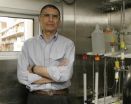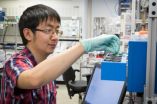(Press-News.org) Based on models and observations, climate scientists have devised a simplified formula to describe one of the consequences of climate change: regions already marked by droughts will continue to dry out in the future climate. Regions that already have a moist climate will experience additional rainfall. In short: dry gets drier; wet gets wetter (DDWW).
However, this formula is less universally valid than previously assumed. This was demonstrated by a team of ETH climate researchers led by Peter Greve, lead author of a study recently published in Nature Geoscience. Traditional analyses use metrics that can comprehensively describe climate characteristics above the ocean, but is problematic over land. While this fact was mentioned in said studies, scientific and public discourse has overlooked this aspect so far. In their new study, the ETH researchers in the group headed by Sonia Seneviratne's, professor for land-climate dynamics, take into account the specific climatic properties of land surfaces, where the amount of available water is limited when compared with the ocean.
In their analysis, the climate scientists made use of measured data compiled solely on land, such as rainfall, actual evaporation and potential evaporation. The data derived from various sources was combined by Greve and his co-authors – this allowed them to extract trends in terms of a region's humidity and dryness. Furthermore, the researchers compared data from between 1948 and 1968 and 1984 to 2004.
Half of the surface areas show divergence
The evaluation shows no obvious trend towards a drier or wetter climate across three-quarters of the land are. There are solid trends for the remaining quarter. However, only half of this surface area follows the DDWW principle, i.e. one-eighth of the total landmass, while the trends seem to contradict this rule over the other half.
Some regions which should have become wetter according to the simple DDWW formula have actually become drier in the past – this includes parts of the Amazon, Central America, tropical Africa and Asia. On the other hand, there are dry areas that have become wetter: parts of Patagonia, central Australia and the Midwestern United States.
Nevertheless, the 'wet gets wetter' rule is largely confirmed for the Eastern United States, Northern Australia and northern Eurasia. 'Dry gets drier' also corresponds to indications in the Sahel region, the Arabian Peninsula and parts of Central Asia and Australia.
However, the DDWW principle does still applies to the oceans. "Our results emphasise how we should not overly rely on simplifying principles to asses past developments in dryness and humidity," Greve explains. This can be misleading, as it cannot do justice to the complexity of the underlying systems.
INFORMATION:
Further reading
Greve P, Orlowsky B, Müller B, Sheffield J, Reichstein M, Seneviratne SI. Global assessment of trends in wetting and drying over land. Nature Geoscience, Advanced Online Publication 14th September 2014. DOI: 10.1038/ngeo2247
Rules of thumb for climate change turned upside down
2014-09-15
ELSE PRESS RELEASES FROM THIS DATE:
Measuring modified protein structures
2014-09-15
Cells regulate protein functions in a wide variety of ways, including by modifying the protein structure. In an instant, a protein can take on another form and perform no or even the "wrong" function: in humans, proteins that fold wrongly can cause serious diseases such as Alzheimer's, Parkinson's or cystic fibrosis. Some of these proteins also have a tendency to "infect" other molecules of the same type and congregate into insoluble so-called amyloid fibrils or plaques. These amyloids can damage cells and tissues and make people ill.
Method breaks the shackles
Until ...
UNC researchers find final pieces to the circadian clock puzzle
2014-09-15
CHAPEL HILL, NC – Researchers at the UNC School of Medicine have discovered how two genes – Period and Cryptochrome – keep the circadian clocks in all human cells in time and in proper rhythm with the 24-hour day, as well as the seasons. The finding, published today in the journal Genes and Development, has implications for the development of drugs for various diseases such as cancers and diabetes, as well as conditions such as metabolic syndrome, insomnia, seasonal affective disorder, obesity, and even jetlag.
"Discovering how these circadian clock genes interact has ...
Cheaper alternative to licensed drug for treating eye disease has similar side-effects
2014-09-15
Health policies which favour using ranibizumab for treating eye disease in older people over safety concerns for a cheaper alternative should take account of a new Cochrane Review published today. The researchers looked at the results of studies which compared the safety of two drugs used for treating age-related macular degeneration, ranibizumab and bevacizumab. Contrary to what was argued by some experts the review has found that the cheaper drug, bevacizumab, does not appear to increase deaths or serious side-effects compared with ranibizumab in people with neovascular ...
Study sheds new light on why batteries go bad
2014-09-15
Menlo Park, Calif. — A comprehensive look at how tiny particles in a lithium ion battery electrode behave shows that rapid-charging the battery and using it to do high-power, rapidly draining work may not be as damaging as researchers had thought – and that the benefits of slow draining and charging may have been overestimated.
The results challenge the prevailing view that "supercharging" batteries is always harder on battery electrodes than charging at slower rates, according to researchers from Stanford University and the Stanford Institute for Materials & Energy Sciences ...
Marijuana users who feel low get high
2014-09-15
PISCATAWAY, NJ – Adolescents and young adults who smoke marijuana frequently may attempt to manage negative moods by using the drug, according to a study in September's Journal of Studies on Alcohol and Drugs.
"Young people who use marijuana frequently experience an increase in negative affect in the 24 hours leading up to a use event, which lends strong support to an affect-regulation model in this population," says the study's lead author Lydia A. Shrier, M.D., M.P.H., of the division of adolescent and young adult medicine at Boston Children's Hospital.
She notes ...
Hypersensitivity to non-painful events may be part of pathology in fibromyalgia
2014-09-15
New research shows that patients with fibromyalgia have hypersensitivity to non-painful events based on images of the patients' brains, which show reduced activation in primary sensory regions and increased activation in sensory integration areas. Findings published in Arthritis & Rheumatology, a journal of the American College of Rheumatology (ACR), suggest that brain abnormalities in response to non-painful sensory stimulation may cause the increased unpleasantness that patients experience in response to daily visual, auditory and tactile stimulation.
Fibromyalgia ...
New knowledge of genes driving bladder cancer points to targeted treatments
2014-09-15
The story of cancer care seems so simple: find the mutated gene that causes cancer and turn it off or fix it. But rarely does a single gene cause cancer. More often, many genes are altered together to drive the disease. So the challenge becomes sorting out which altered genes are the most to blame in which cancers. A collaborative study between researchers at the University of Colorado Cancer Center and the National Cancer Institute (NCI) published today in the journal Clinical Cancer Research takes an important step toward answering this question in bladder cancer.
Specifically, ...
Identifying a better message strategy for dissuading smokers: Add the positive
2014-09-15
WASHINGTON — Which is more likely to convince a smoker to quit? The words, "Warning: cigarettes cause cancer" beneath the image of an open mouth with a cancerous lesion and rotten teeth, or the same image with the words, "Warning: Quitting smoking reduces the risk of cancer"?
The answer depends on how confident you are in your ability to quit, according to a study led by researchers at Georgetown Lombardi Comprehensive Cancer Center and published in the journal Nicotine & Tobacco Research.
The research, which involved 740 participants and three D.C. area institutions, ...
To curb violent tendencies, start young
2014-09-15
DURHAM, N.C. -- Aggressive children are less likely to become violent criminals or psychiatrically troubled adults if they receive early intervention, says a new study based on more than two decades of research.
These findings from researchers at Duke, Pennsylvania State and Vanderbilt universities and the University of Washington are based on the Fast Track Project, a multi-faceted program that is one of the largest violence-prevention trials ever funded by the federal government.
Beginning in 1991, the researchers screened nearly 10,000 5-year-old children in Durham, ...
Schizophrenia not a single disease but multiple genetically distinct disorders
2014-09-15
AUDIO:
New research shows that schizophrenia isn't a single disease but a group of eight genetically distinct disorders, each with its own set of symptoms. The finding could be a first...
Click here for more information.
New research shows that schizophrenia isn't a single disease but a group of eight genetically distinct disorders, each with its own set of symptoms. The finding could be a first step toward improved diagnosis and treatment for the debilitating psychiatric illness.
The ...



